Business Communication Skills: Analysis of Governance Articles Report
VerifiedAdded on 2022/11/26
|9
|1778
|279
Report
AI Summary
This report critically examines two peer-reviewed articles, "Governance for Good" and "The Governance of Non-Profit Firms," focusing on business communication skills within the context of charity and non-profit organizations. The report analyzes the central arguments of each article, highlighting the importance of good governance in charities and the differences between for-profit and non-profit governance structures. The analysis includes the responsibilities of board members, the legal and ethical considerations they must adhere to, and the challenges non-profit organizations face in maintaining effective governance. The report also contrasts the recommendations made in each article, such as the importance of board members acting with diligence and the application of a model for non-profit firms. Furthermore, it differentiates the articles by discussing their focus, arguments, recommendations, and legal considerations, ultimately aiming to provide a comprehensive understanding of governance within these sectors. The report concludes by summarizing the key findings and implications of the analysis.
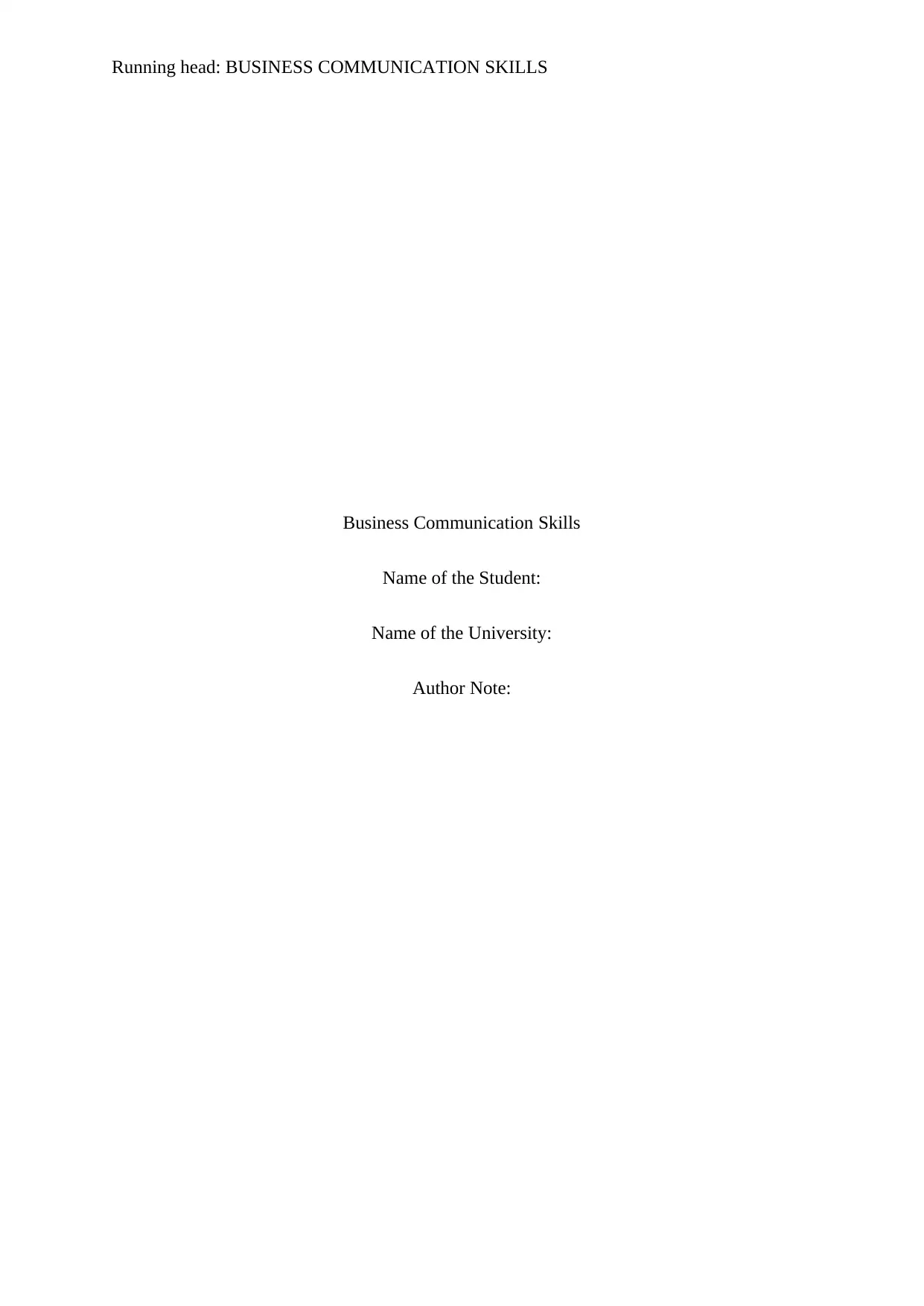
Running head: BUSINESS COMMUNICATION SKILLS
Business Communication Skills
Name of the Student:
Name of the University:
Author Note:
Business Communication Skills
Name of the Student:
Name of the University:
Author Note:
Paraphrase This Document
Need a fresh take? Get an instant paraphrase of this document with our AI Paraphraser

1BUSINESS COMMUNICATION SKILLS
Table of Contents
Introduction................................................................................................................................2
Argument....................................................................................................................................2
The difference between the two articles.....................................................................................5
Conclusion..................................................................................................................................6
References..................................................................................................................................7
Table of Contents
Introduction................................................................................................................................2
Argument....................................................................................................................................2
The difference between the two articles.....................................................................................5
Conclusion..................................................................................................................................6
References..................................................................................................................................7
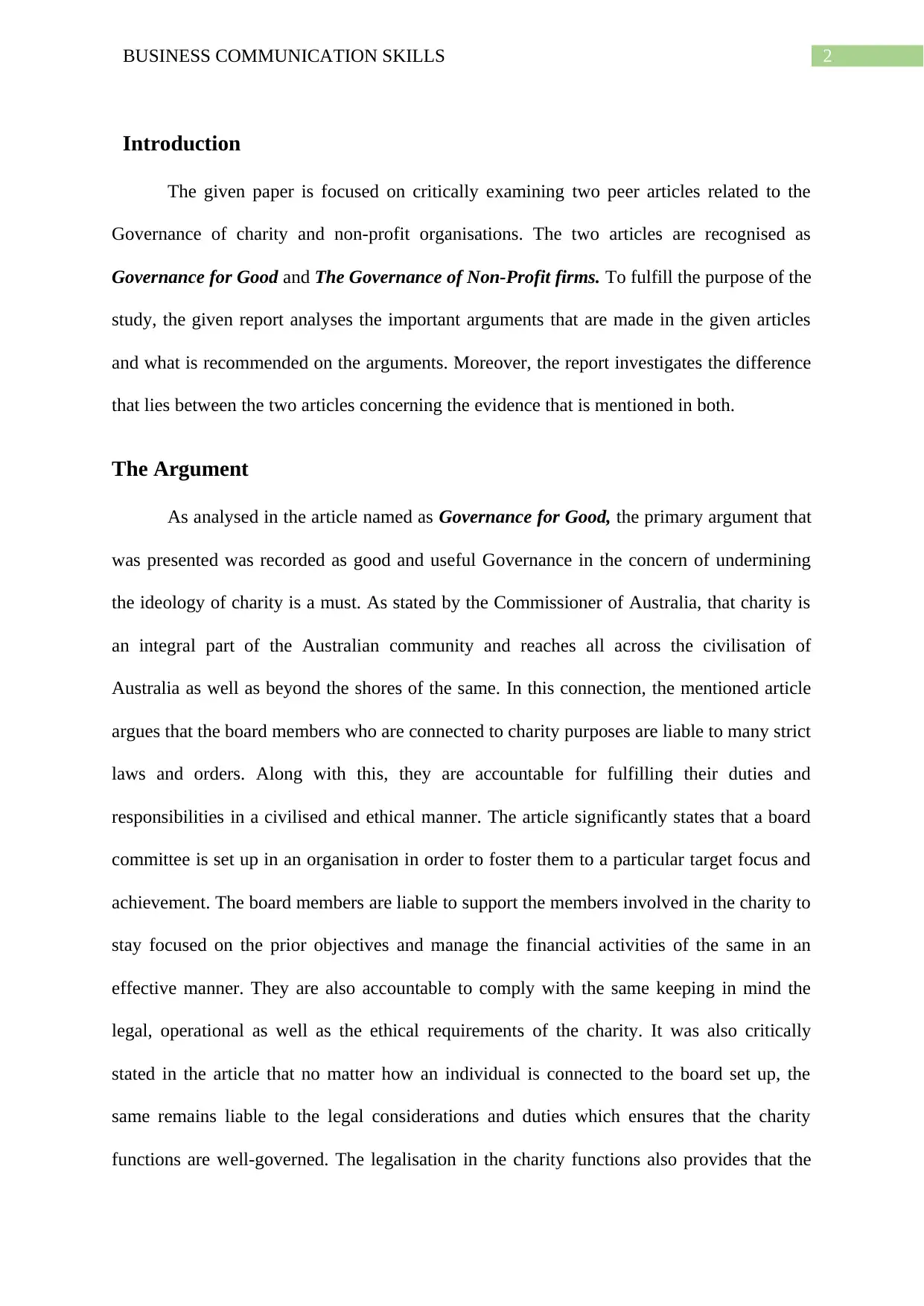
2BUSINESS COMMUNICATION SKILLS
Introduction
The given paper is focused on critically examining two peer articles related to the
Governance of charity and non-profit organisations. The two articles are recognised as
Governance for Good and The Governance of Non-Profit firms. To fulfill the purpose of the
study, the given report analyses the important arguments that are made in the given articles
and what is recommended on the arguments. Moreover, the report investigates the difference
that lies between the two articles concerning the evidence that is mentioned in both.
The Argument
As analysed in the article named as Governance for Good, the primary argument that
was presented was recorded as good and useful Governance in the concern of undermining
the ideology of charity is a must. As stated by the Commissioner of Australia, that charity is
an integral part of the Australian community and reaches all across the civilisation of
Australia as well as beyond the shores of the same. In this connection, the mentioned article
argues that the board members who are connected to charity purposes are liable to many strict
laws and orders. Along with this, they are accountable for fulfilling their duties and
responsibilities in a civilised and ethical manner. The article significantly states that a board
committee is set up in an organisation in order to foster them to a particular target focus and
achievement. The board members are liable to support the members involved in the charity to
stay focused on the prior objectives and manage the financial activities of the same in an
effective manner. They are also accountable to comply with the same keeping in mind the
legal, operational as well as the ethical requirements of the charity. It was also critically
stated in the article that no matter how an individual is connected to the board set up, the
same remains liable to the legal considerations and duties which ensures that the charity
functions are well-governed. The legalisation in the charity functions also provides that the
Introduction
The given paper is focused on critically examining two peer articles related to the
Governance of charity and non-profit organisations. The two articles are recognised as
Governance for Good and The Governance of Non-Profit firms. To fulfill the purpose of the
study, the given report analyses the important arguments that are made in the given articles
and what is recommended on the arguments. Moreover, the report investigates the difference
that lies between the two articles concerning the evidence that is mentioned in both.
The Argument
As analysed in the article named as Governance for Good, the primary argument that
was presented was recorded as good and useful Governance in the concern of undermining
the ideology of charity is a must. As stated by the Commissioner of Australia, that charity is
an integral part of the Australian community and reaches all across the civilisation of
Australia as well as beyond the shores of the same. In this connection, the mentioned article
argues that the board members who are connected to charity purposes are liable to many strict
laws and orders. Along with this, they are accountable for fulfilling their duties and
responsibilities in a civilised and ethical manner. The article significantly states that a board
committee is set up in an organisation in order to foster them to a particular target focus and
achievement. The board members are liable to support the members involved in the charity to
stay focused on the prior objectives and manage the financial activities of the same in an
effective manner. They are also accountable to comply with the same keeping in mind the
legal, operational as well as the ethical requirements of the charity. It was also critically
stated in the article that no matter how an individual is connected to the board set up, the
same remains liable to the legal considerations and duties which ensures that the charity
functions are well-governed. The legalisation in the charity functions also provides that the
⊘ This is a preview!⊘
Do you want full access?
Subscribe today to unlock all pages.

Trusted by 1+ million students worldwide
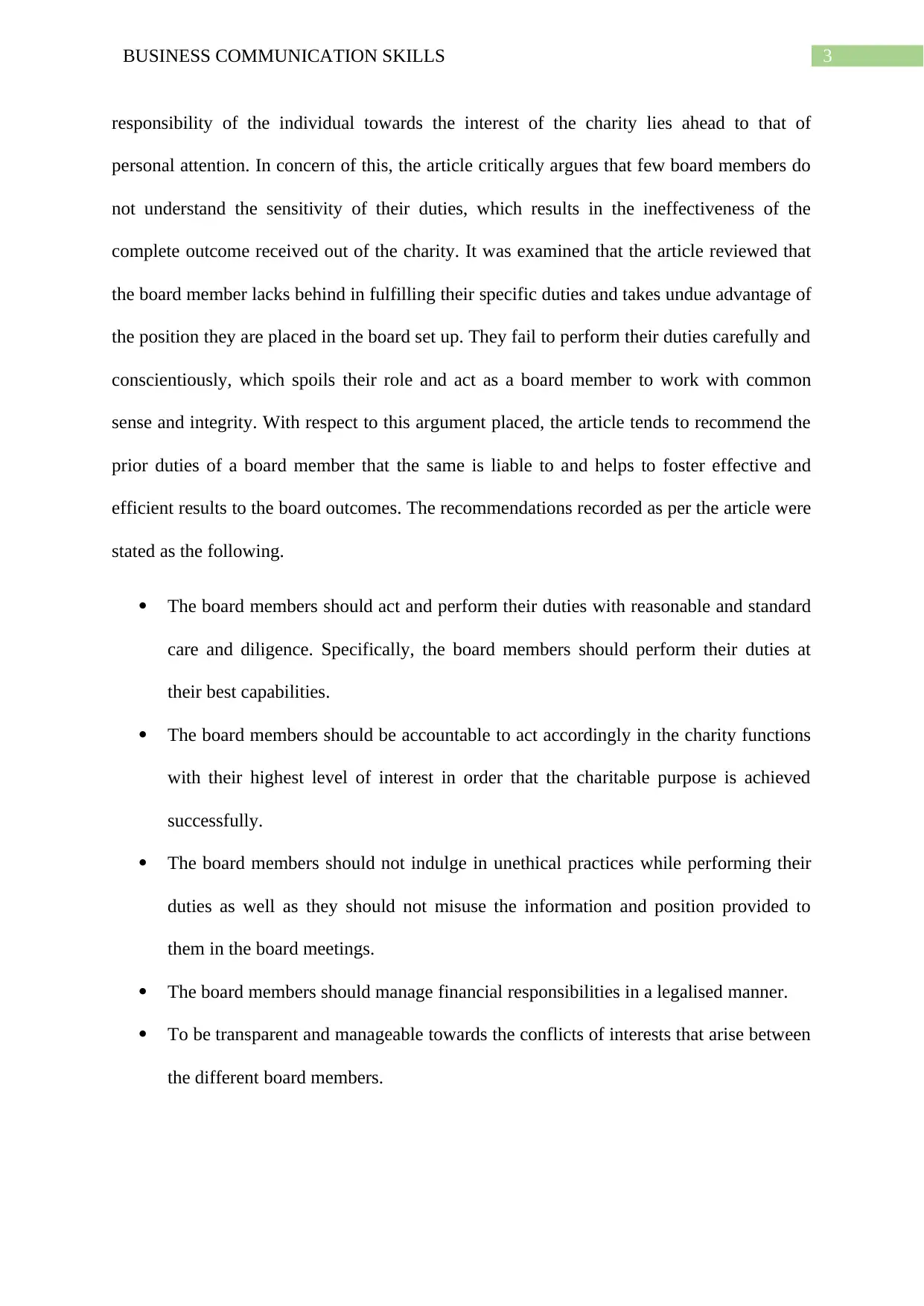
3BUSINESS COMMUNICATION SKILLS
responsibility of the individual towards the interest of the charity lies ahead to that of
personal attention. In concern of this, the article critically argues that few board members do
not understand the sensitivity of their duties, which results in the ineffectiveness of the
complete outcome received out of the charity. It was examined that the article reviewed that
the board member lacks behind in fulfilling their specific duties and takes undue advantage of
the position they are placed in the board set up. They fail to perform their duties carefully and
conscientiously, which spoils their role and act as a board member to work with common
sense and integrity. With respect to this argument placed, the article tends to recommend the
prior duties of a board member that the same is liable to and helps to foster effective and
efficient results to the board outcomes. The recommendations recorded as per the article were
stated as the following.
The board members should act and perform their duties with reasonable and standard
care and diligence. Specifically, the board members should perform their duties at
their best capabilities.
The board members should be accountable to act accordingly in the charity functions
with their highest level of interest in order that the charitable purpose is achieved
successfully.
The board members should not indulge in unethical practices while performing their
duties as well as they should not misuse the information and position provided to
them in the board meetings.
The board members should manage financial responsibilities in a legalised manner.
To be transparent and manageable towards the conflicts of interests that arise between
the different board members.
responsibility of the individual towards the interest of the charity lies ahead to that of
personal attention. In concern of this, the article critically argues that few board members do
not understand the sensitivity of their duties, which results in the ineffectiveness of the
complete outcome received out of the charity. It was examined that the article reviewed that
the board member lacks behind in fulfilling their specific duties and takes undue advantage of
the position they are placed in the board set up. They fail to perform their duties carefully and
conscientiously, which spoils their role and act as a board member to work with common
sense and integrity. With respect to this argument placed, the article tends to recommend the
prior duties of a board member that the same is liable to and helps to foster effective and
efficient results to the board outcomes. The recommendations recorded as per the article were
stated as the following.
The board members should act and perform their duties with reasonable and standard
care and diligence. Specifically, the board members should perform their duties at
their best capabilities.
The board members should be accountable to act accordingly in the charity functions
with their highest level of interest in order that the charitable purpose is achieved
successfully.
The board members should not indulge in unethical practices while performing their
duties as well as they should not misuse the information and position provided to
them in the board meetings.
The board members should manage financial responsibilities in a legalised manner.
To be transparent and manageable towards the conflicts of interests that arise between
the different board members.
Paraphrase This Document
Need a fresh take? Get an instant paraphrase of this document with our AI Paraphraser
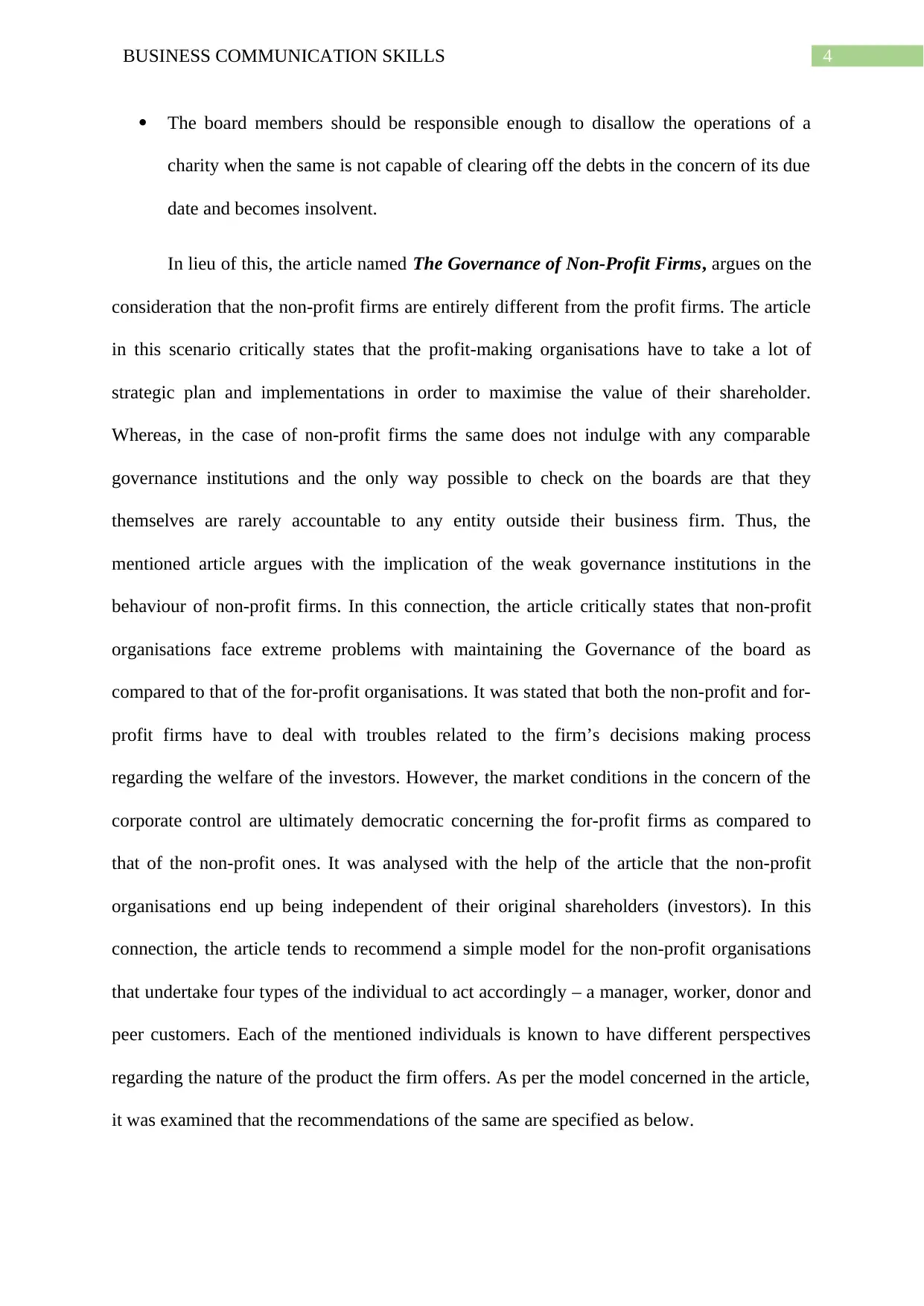
4BUSINESS COMMUNICATION SKILLS
The board members should be responsible enough to disallow the operations of a
charity when the same is not capable of clearing off the debts in the concern of its due
date and becomes insolvent.
In lieu of this, the article named The Governance of Non-Profit Firms, argues on the
consideration that the non-profit firms are entirely different from the profit firms. The article
in this scenario critically states that the profit-making organisations have to take a lot of
strategic plan and implementations in order to maximise the value of their shareholder.
Whereas, in the case of non-profit firms the same does not indulge with any comparable
governance institutions and the only way possible to check on the boards are that they
themselves are rarely accountable to any entity outside their business firm. Thus, the
mentioned article argues with the implication of the weak governance institutions in the
behaviour of non-profit firms. In this connection, the article critically states that non-profit
organisations face extreme problems with maintaining the Governance of the board as
compared to that of the for-profit organisations. It was stated that both the non-profit and for-
profit firms have to deal with troubles related to the firm’s decisions making process
regarding the welfare of the investors. However, the market conditions in the concern of the
corporate control are ultimately democratic concerning the for-profit firms as compared to
that of the non-profit ones. It was analysed with the help of the article that the non-profit
organisations end up being independent of their original shareholders (investors). In this
connection, the article tends to recommend a simple model for the non-profit organisations
that undertake four types of the individual to act accordingly – a manager, worker, donor and
peer customers. Each of the mentioned individuals is known to have different perspectives
regarding the nature of the product the firm offers. As per the model concerned in the article,
it was examined that the recommendations of the same are specified as below.
The board members should be responsible enough to disallow the operations of a
charity when the same is not capable of clearing off the debts in the concern of its due
date and becomes insolvent.
In lieu of this, the article named The Governance of Non-Profit Firms, argues on the
consideration that the non-profit firms are entirely different from the profit firms. The article
in this scenario critically states that the profit-making organisations have to take a lot of
strategic plan and implementations in order to maximise the value of their shareholder.
Whereas, in the case of non-profit firms the same does not indulge with any comparable
governance institutions and the only way possible to check on the boards are that they
themselves are rarely accountable to any entity outside their business firm. Thus, the
mentioned article argues with the implication of the weak governance institutions in the
behaviour of non-profit firms. In this connection, the article critically states that non-profit
organisations face extreme problems with maintaining the Governance of the board as
compared to that of the for-profit organisations. It was stated that both the non-profit and for-
profit firms have to deal with troubles related to the firm’s decisions making process
regarding the welfare of the investors. However, the market conditions in the concern of the
corporate control are ultimately democratic concerning the for-profit firms as compared to
that of the non-profit ones. It was analysed with the help of the article that the non-profit
organisations end up being independent of their original shareholders (investors). In this
connection, the article tends to recommend a simple model for the non-profit organisations
that undertake four types of the individual to act accordingly – a manager, worker, donor and
peer customers. Each of the mentioned individuals is known to have different perspectives
regarding the nature of the product the firm offers. As per the model concerned in the article,
it was examined that the recommendations of the same are specified as below.
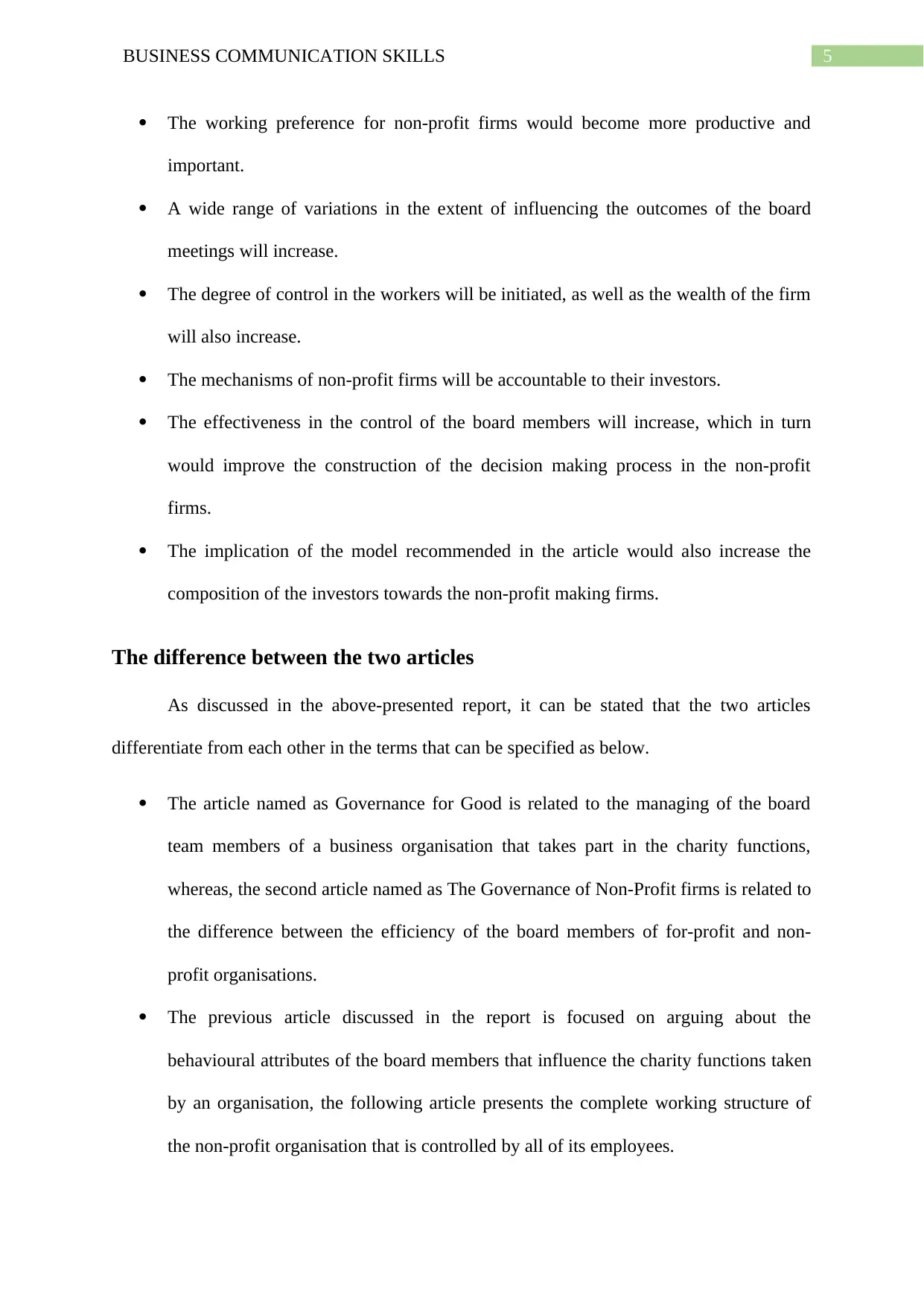
5BUSINESS COMMUNICATION SKILLS
The working preference for non-profit firms would become more productive and
important.
A wide range of variations in the extent of influencing the outcomes of the board
meetings will increase.
The degree of control in the workers will be initiated, as well as the wealth of the firm
will also increase.
The mechanisms of non-profit firms will be accountable to their investors.
The effectiveness in the control of the board members will increase, which in turn
would improve the construction of the decision making process in the non-profit
firms.
The implication of the model recommended in the article would also increase the
composition of the investors towards the non-profit making firms.
The difference between the two articles
As discussed in the above-presented report, it can be stated that the two articles
differentiate from each other in the terms that can be specified as below.
The article named as Governance for Good is related to the managing of the board
team members of a business organisation that takes part in the charity functions,
whereas, the second article named as The Governance of Non-Profit firms is related to
the difference between the efficiency of the board members of for-profit and non-
profit organisations.
The previous article discussed in the report is focused on arguing about the
behavioural attributes of the board members that influence the charity functions taken
by an organisation, the following article presents the complete working structure of
the non-profit organisation that is controlled by all of its employees.
The working preference for non-profit firms would become more productive and
important.
A wide range of variations in the extent of influencing the outcomes of the board
meetings will increase.
The degree of control in the workers will be initiated, as well as the wealth of the firm
will also increase.
The mechanisms of non-profit firms will be accountable to their investors.
The effectiveness in the control of the board members will increase, which in turn
would improve the construction of the decision making process in the non-profit
firms.
The implication of the model recommended in the article would also increase the
composition of the investors towards the non-profit making firms.
The difference between the two articles
As discussed in the above-presented report, it can be stated that the two articles
differentiate from each other in the terms that can be specified as below.
The article named as Governance for Good is related to the managing of the board
team members of a business organisation that takes part in the charity functions,
whereas, the second article named as The Governance of Non-Profit firms is related to
the difference between the efficiency of the board members of for-profit and non-
profit organisations.
The previous article discussed in the report is focused on arguing about the
behavioural attributes of the board members that influence the charity functions taken
by an organisation, the following article presents the complete working structure of
the non-profit organisation that is controlled by all of its employees.
⊘ This is a preview!⊘
Do you want full access?
Subscribe today to unlock all pages.

Trusted by 1+ million students worldwide
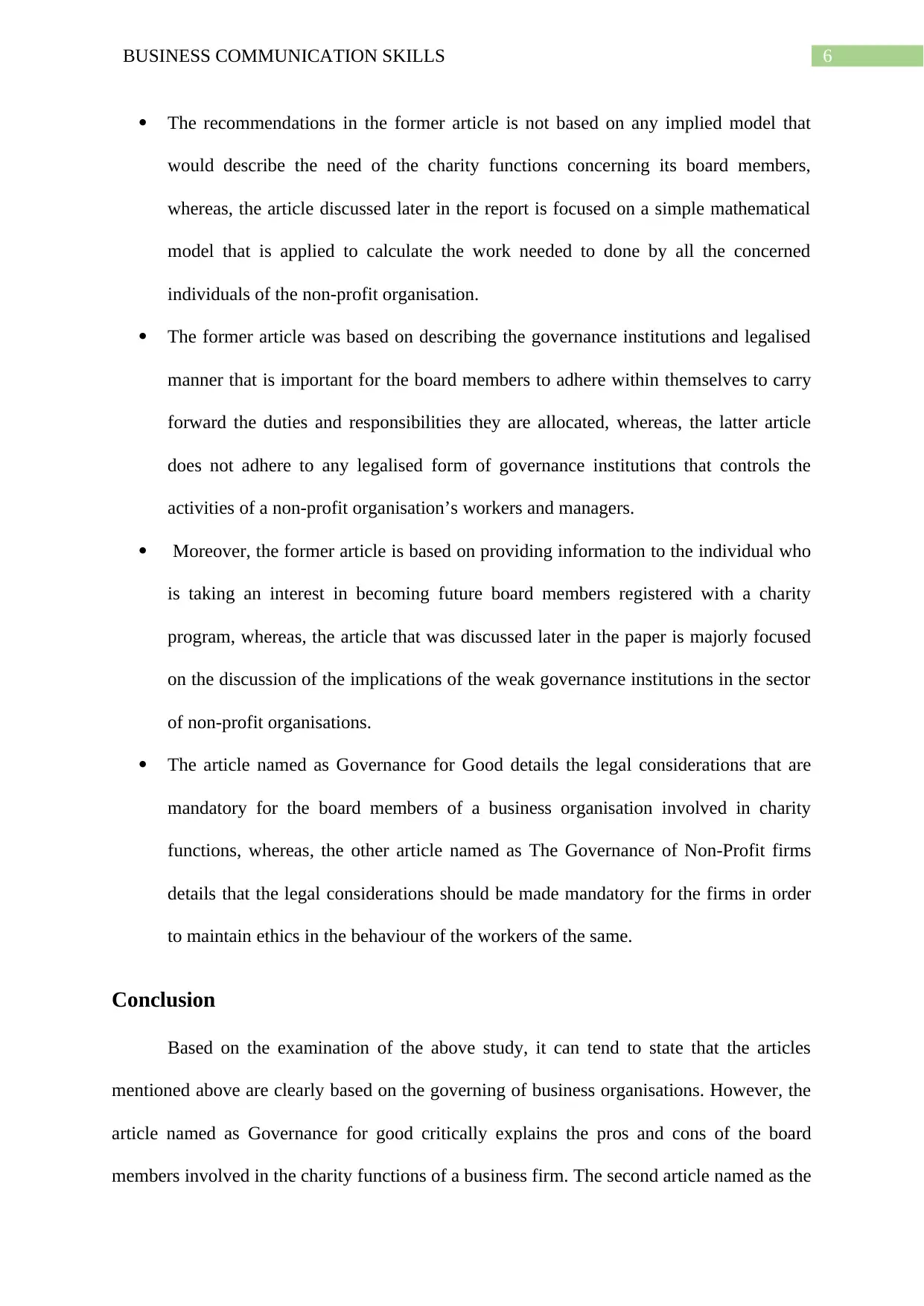
6BUSINESS COMMUNICATION SKILLS
The recommendations in the former article is not based on any implied model that
would describe the need of the charity functions concerning its board members,
whereas, the article discussed later in the report is focused on a simple mathematical
model that is applied to calculate the work needed to done by all the concerned
individuals of the non-profit organisation.
The former article was based on describing the governance institutions and legalised
manner that is important for the board members to adhere within themselves to carry
forward the duties and responsibilities they are allocated, whereas, the latter article
does not adhere to any legalised form of governance institutions that controls the
activities of a non-profit organisation’s workers and managers.
Moreover, the former article is based on providing information to the individual who
is taking an interest in becoming future board members registered with a charity
program, whereas, the article that was discussed later in the paper is majorly focused
on the discussion of the implications of the weak governance institutions in the sector
of non-profit organisations.
The article named as Governance for Good details the legal considerations that are
mandatory for the board members of a business organisation involved in charity
functions, whereas, the other article named as The Governance of Non-Profit firms
details that the legal considerations should be made mandatory for the firms in order
to maintain ethics in the behaviour of the workers of the same.
Conclusion
Based on the examination of the above study, it can tend to state that the articles
mentioned above are clearly based on the governing of business organisations. However, the
article named as Governance for good critically explains the pros and cons of the board
members involved in the charity functions of a business firm. The second article named as the
The recommendations in the former article is not based on any implied model that
would describe the need of the charity functions concerning its board members,
whereas, the article discussed later in the report is focused on a simple mathematical
model that is applied to calculate the work needed to done by all the concerned
individuals of the non-profit organisation.
The former article was based on describing the governance institutions and legalised
manner that is important for the board members to adhere within themselves to carry
forward the duties and responsibilities they are allocated, whereas, the latter article
does not adhere to any legalised form of governance institutions that controls the
activities of a non-profit organisation’s workers and managers.
Moreover, the former article is based on providing information to the individual who
is taking an interest in becoming future board members registered with a charity
program, whereas, the article that was discussed later in the paper is majorly focused
on the discussion of the implications of the weak governance institutions in the sector
of non-profit organisations.
The article named as Governance for Good details the legal considerations that are
mandatory for the board members of a business organisation involved in charity
functions, whereas, the other article named as The Governance of Non-Profit firms
details that the legal considerations should be made mandatory for the firms in order
to maintain ethics in the behaviour of the workers of the same.
Conclusion
Based on the examination of the above study, it can tend to state that the articles
mentioned above are clearly based on the governing of business organisations. However, the
article named as Governance for good critically explains the pros and cons of the board
members involved in the charity functions of a business firm. The second article named as the
Paraphrase This Document
Need a fresh take? Get an instant paraphrase of this document with our AI Paraphraser

7BUSINESS COMMUNICATION SKILLS
Governance of the Non-Profit firms is based on the board members as well as the other
workers who are related to the working plans and processes of non-profit making
organisations.
Governance of the Non-Profit firms is based on the board members as well as the other
workers who are related to the working plans and processes of non-profit making
organisations.
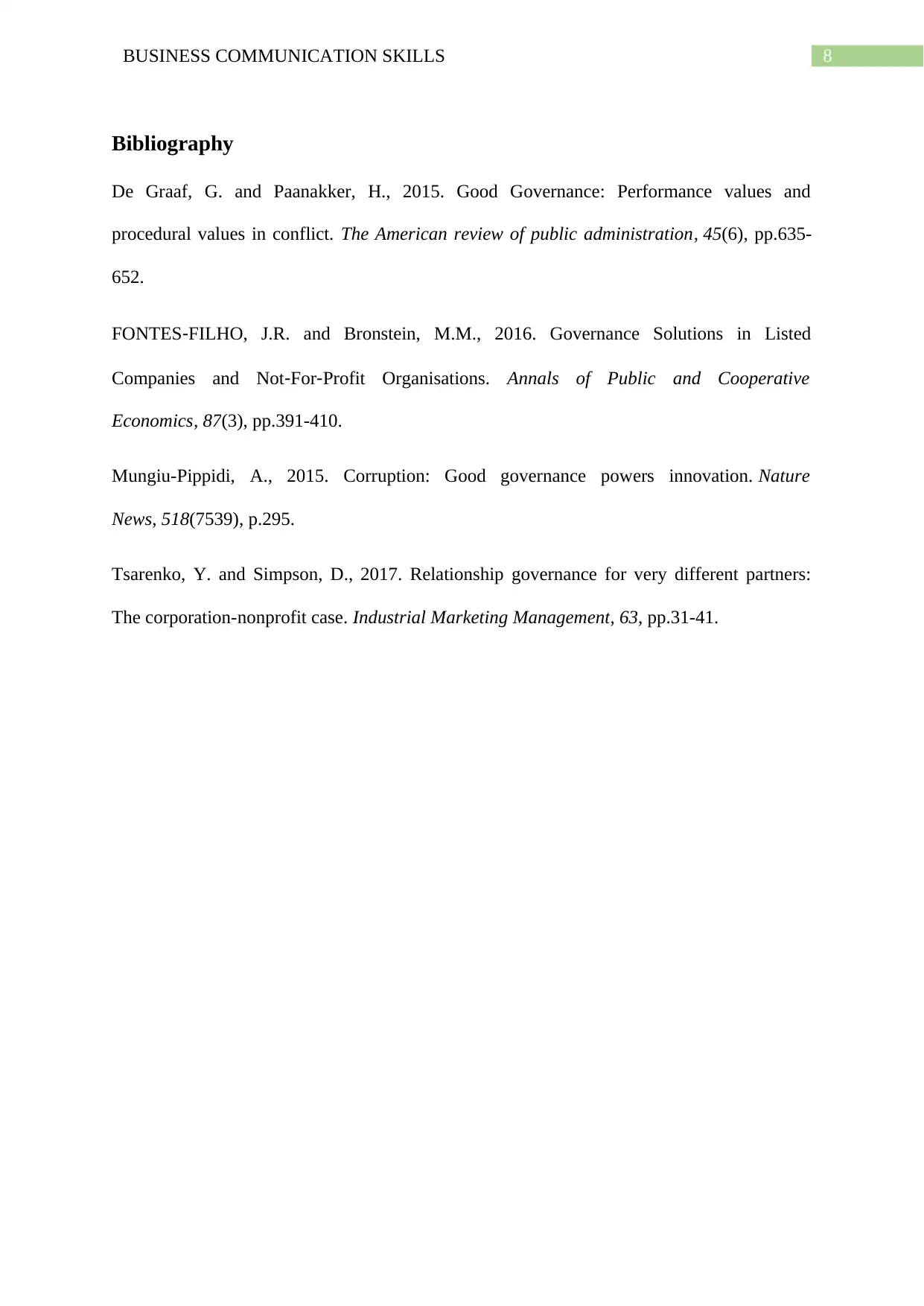
8BUSINESS COMMUNICATION SKILLS
Bibliography
De Graaf, G. and Paanakker, H., 2015. Good Governance: Performance values and
procedural values in conflict. The American review of public administration, 45(6), pp.635-
652.
FONTES‐FILHO, J.R. and Bronstein, M.M., 2016. Governance Solutions in Listed
Companies and Not‐For‐Profit Organisations. Annals of Public and Cooperative
Economics, 87(3), pp.391-410.
Mungiu-Pippidi, A., 2015. Corruption: Good governance powers innovation. Nature
News, 518(7539), p.295.
Tsarenko, Y. and Simpson, D., 2017. Relationship governance for very different partners:
The corporation-nonprofit case. Industrial Marketing Management, 63, pp.31-41.
Bibliography
De Graaf, G. and Paanakker, H., 2015. Good Governance: Performance values and
procedural values in conflict. The American review of public administration, 45(6), pp.635-
652.
FONTES‐FILHO, J.R. and Bronstein, M.M., 2016. Governance Solutions in Listed
Companies and Not‐For‐Profit Organisations. Annals of Public and Cooperative
Economics, 87(3), pp.391-410.
Mungiu-Pippidi, A., 2015. Corruption: Good governance powers innovation. Nature
News, 518(7539), p.295.
Tsarenko, Y. and Simpson, D., 2017. Relationship governance for very different partners:
The corporation-nonprofit case. Industrial Marketing Management, 63, pp.31-41.
⊘ This is a preview!⊘
Do you want full access?
Subscribe today to unlock all pages.

Trusted by 1+ million students worldwide
1 out of 9
Related Documents
Your All-in-One AI-Powered Toolkit for Academic Success.
+13062052269
info@desklib.com
Available 24*7 on WhatsApp / Email
![[object Object]](/_next/static/media/star-bottom.7253800d.svg)
Unlock your academic potential
Copyright © 2020–2025 A2Z Services. All Rights Reserved. Developed and managed by ZUCOL.




